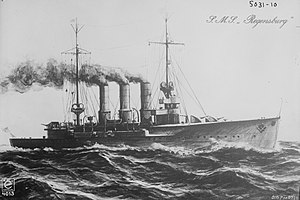
Back Regensburg (Schiff, 1915) German اساماس رگنسبورگ Persian SMS Regensburg (1914) Finnish SMS Regensburg French רגנסבורג (סיירת, 1914) HE ストラスブール (軽巡洋艦) Japanese 雷根斯堡号小巡洋舰 Chinese
 Postcard depicting a sketch of Regensburg
| |
| History | |
|---|---|
| Name | Regenseburg |
| Namesake | City of Regensburg |
| Builder | AG Weser, Bremen |
| Laid down | 14 November 1912 |
| Launched | 25 April 1914 |
| Commissioned | 3 January 1915 |
| Stricken | 10 March 1920 |
| Fate | Ceded to France |
| Name | Strasbourg |
| Namesake | City of Strasbourg |
| Acquired | 4 June 1920 |
| Out of service | 14 June 1936 |
| Fate | Scuttled in Lorient, 1944 |
| General characteristics | |
| Class and type | Graudenz-class cruiser |
| Displacement | |
| Length | 142.7 m (468 ft 2 in) |
| Beam | 13.8 m (45 ft 3 in) |
| Draft | 5.75 m (18 ft 10 in) |
| Installed power |
|
| Propulsion |
|
| Speed | 27.5 kn (50.9 km/h) |
| Range | 5,500 nmi (10,200 km; 6,300 mi) at 12 kn (22 km/h; 14 mph) |
| Crew |
|
| Armament |
|
| Armor |
|
SMS Regensburg was a light cruiser of the Graudenz class built by the German Kaiserliche Marine (Imperial Navy). She had one sister ship, SMS Graudenz. The ship was built by the AG Weser shipyard in Bremen, laid down in 1912, launched in April 1914, and commissioned into active service in January 1915. She was named for the German town of Regensburg. The ship was armed with a main battery of twelve 10.5 cm SK L/45 guns and had a top speed of 27.5 knots (50.9 km/h; 31.6 mph), though in 1917 she was rearmed with seven 15 cm SK L/45 guns.
Regensburg served in the reconnaissance forces of the High Seas Fleet during World War I. She saw significant action at the Battle of Jutland on 31 May – 1 June 1916, where she served as the leader of the torpedo boat flotillas that screened for the I Scouting Group battlecruisers. After the end of the war, she was ceded to France in 1920 and renamed Strasbourg. In 1928 she took part in the Arctic rescue operations searching for the Airship Italia. Removed from service in 1936, she was used as a barracks ship in Lorient until 1944, when she was seized by the Germans and scuttled in the harbor to protect the U-boat pens there.
© MMXXIII Rich X Search. We shall prevail. All rights reserved. Rich X Search